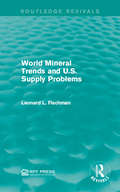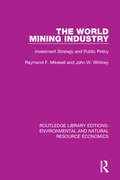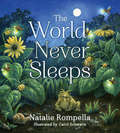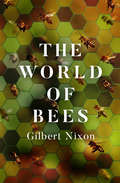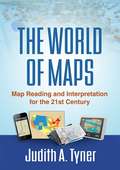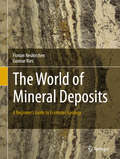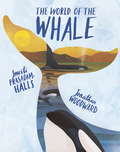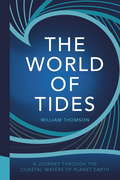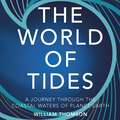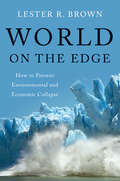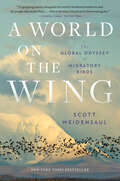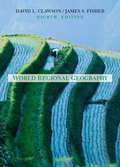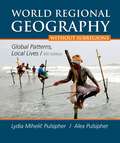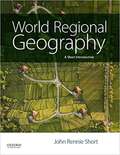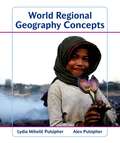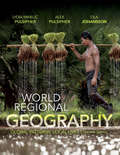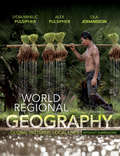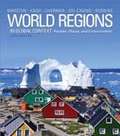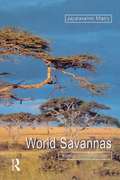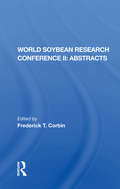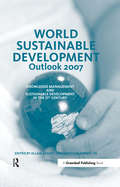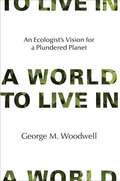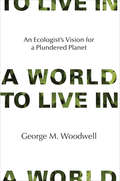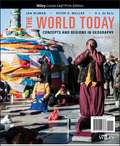- Table View
- List View
World Mineral Trends and U.S. Supply Problems (Routledge Revivals)
by Leonard L. FischmanEven though the United States relies heavily on imports for many non-fuel minerals, mineral supply has played only a small role in foreign policy since World War II. Originally published in 1980, this report investigates seven major non-fuel minerals in relation to long-term potential supply and price problems and any short-term issues that may arise to put concerns about supply in perspective for policy-makers. This title will be of interest to students of Environmental Studies and professionals.
The World Mining Industry: Investment Strategy and Public Policy (Routledge Library Editions: Environmental and Natural Resource Economics)
by Raymond F. Mikesell John W. WhitneyOriginally published in 1987. A powerful combination of the authors’ research and practical experience underpin this book’s treatment of management and financial strategy in the world mining industry. In contrast with highly theoretical economic treatises on the extractive industries, this account deals with the practical realities of the economic, technical and business structure of the industry, the managerial and investment strategies, and the principle public policy issues. This book will interest all students and researchers in resource economics and it will be useful to officials of mining companies, government agencies, and financing agencies. Economic geologists and environmentalists should also find it relevant to their interests.
The World Never Sleeps (Tilbury House Nature Book #0)
by Natalie Rompella Carol SchwartzMidnight. Stars speckle the darkness with bits of light. A cockroach skitters across the kitchen floor to snatch a forgotten breadcrumb. In the backyard, a spider weaves an intricate design on the fence. Winged insects dance and flicker in the porch light. Day and night, small creatures are busy working, eating, hunting, hiding. This nonfiction picture book reveals the hidden lives of insects and other small creatures from one midnight to the next. The world may appear to be sleeping in the dead of night, but it is not. As moonflowers open and stars shine, nature goes about her business. The world never sleeps. Natalie Rompella’s lyrical text is vividly complemented by Carol Schwartz’s watercolors. A cat roams through the illustrations—silent witness, in the house and in the yard, to the myriad lives of night and day. A sense of mystery pervades all—even the backmatter natural-history portraits of the animals met in the book. This nature book invites children into a parallel universe, one that teems with life while they sleep. Lexile Level 700; F&P Level O
The World of Bees
by Gilbert NixonAn entomologist presents a beautifully illustrated study of bees, from their behavior to social structures, colonies, and relationship to the environment. In this engaging and scholarly volume, entomologist Gilbert Nixon shares his lifelong fascination with bees. Nixon&’s childhood love of these curious insects led to decades of study as he learned to identify their distinctive markings and pursued the secrets of their mystifying behaviors.The World of Bees offers a comprehensive introduction to various species of bees, including honey bees, bumblebees, and leafcutter bees, as well as information on related insects such as botflies and wasps. With color illustrations by Arthur Smith, this expert volume covers all major topics in melittology, including mating habits, life cycles, pollination, bee dances, and more.
The World of Maps
by Judith A. TynerMaps have power--they can instruct, make life easier, mislead, or even lie. This engaging text provides the tools to read, analyze, and use any kind of map and assess its strengths and weaknesses. Requiring no advanced math skills, the book presents basic concepts of symbolization, scale, coordinate systems, and projections. It gives students a deeper understanding of the types of maps they encounter every day, from turn-by-turn driving directions to the TV weather report. Readers also learn how to use multiple maps and imagery to analyze an area or region. The book includes 168 figures, among them 22 color plates; most of the figures can be downloaded as PowerPoint slides from the companion website. Appendices contain a glossary, recommended resources, a table of commonly used projections, and more.
The World of Mineral Deposits: A Beginner's Guide to Economic Geology
by Florian Neukirchen Gunnar RiesThis vivid introduction to economic geology not only describes the most important deposit types, but also the processes involved in their formation. Magmatic, hydrothermal and sedimentary processes as well as weathering and alteration are explained in the framework of plate tectonics and the history of the Earth. The chapter about fossil fuels includes unconventional deposits and the much-debated fracking. Other topics covered are exploration, mining and economic aspects like commodity prices.
The World of the Whale
by Smriti Prasadam-HallsDive into the underwater world of whales and dolphins in this entrancing illustrated guide. Graceful and serene, intelligent and social, the whale is a wonder of the deep blue sea. And yet, whales rely on air to breathe - they are mammals, just like us.With breathtaking text, Smriti Prasadam-Halls explores the migrations, songs and family life of these mysterious creatures, and reveals the dangers they face from plastic, pollution and hunting. Wildlife illustrator Jonathan Woodward brings the marine world to life with stunning papercut collage artwork. An astonishing follow-up to the English 4-11 Award-winning book The Ways of the Wolf, which is also shortlisted for the SLA Award.'The expressive writing and the colourful, original artwork depict the lives of whales perfectly. Perceptively illustrating their strong social nature and intelligence, this beautiful book also explores the dangers faced by these incredible creatures and the need for us to work together to protect them.' - Whale & Dolphin Conservation
The World of Tides: A Journey Through the Coastal Waters of Planet Earth
by William ThomsonIn The Book of Tides, William Thomson took the reader on a mesmerising journey round the coast of Britain. Now, he sets out with his surfboard and tidal compass to encounter the waters of the world, charting his most extraordinary sights and experiences. These include the whirlpools of the Arctic circle, the world's biggest ever surfed wave off Portugal, the strongest whirlpool in Norway and, in Australia, the most dangerous rapids known to us.With the enticing combination of William's passionate text and collectable mapping illustrations, this is a book for anyone who feels the pull of the tides and call of the sea.FEATURING:New ZealandAustraliaPortugalFranceEnglandScotlandNorwayThe NetherlandsSpainIndonesiaChinaJapanUSACanadaBelize
The World of Tides: A Journey Through the Coastal Waters of Planet Earth
by William ThomsonIn The Book of Tides, William Thomson took the reader on a mesmerising journey round the coast of Britain. Now, he sets out with his surfboard and tidal compass to encounter the waters of the world, charting his most extraordinary sights and experiences. These include the whirlpools of the Arctic circle, the world's biggest ever surfed wave off Portugal, the strongest whirlpool in Norway and, in Australia, the most dangerous rapids known to us.With the enticing combination of William's passionate text and collectible mapping illustrations, this is a book for anyone who feels the pull of the tides and call of the sea.FEATURING:New ZealandAustraliaPortugalFranceEnglandScotlandNorwayThe NetherlandsSpainIndonesiaChinaJapanUSACanadaBelize(P)2017 Quercus Editions Limited
World on the Edge: How to Prevent Environmental and Economic Collapse
by Lester R. BrownIn this urgent time, World on the Edge calls out the pivotal environmental issues and how to solve them now. We are in a race between political and natural tipping points. Can we close coal-fired power plants fast enough to save the Greenland ice sheet and avoid catastrophic sea level rise? Can we raise water productivity fast enough to halt the depletion of aquifers and avoid water-driven food shortages? Can we cope with peak water and peak oil at the same time? These are some of the issues Lester R. Brown skillfully distills in World on the Edge. Bringing decades of research and analysis into play, he provides the responses needed to reclaim our future.
A World on the Wing: The Global Odyssey Of Migratory Birds
by Scott WeidensaulNew York Times Bestseller Finalist for the Los Angeles Times Book Prize A Library Journal Best Science and Technology Book of the Year An exhilarating exploration of the science and wonder of global bird migration. In the past two decades, our understanding of the navigational and physiological feats that enable birds to cross immense oceans, fly above the highest mountains, or remain in unbroken flight for months at a stretch has exploded. What we’ve learned of these key migrations—how billions of birds circumnavigate the globe, flying tens of thousands of miles between hemispheres on an annual basis—is nothing short of extraordinary. Bird migration entails almost unfathomable endurance, like a sparrow-sized sandpiper that will fly nonstop from Canada to Venezuela—the equivalent of running 126 consecutive marathons without food, water, or rest—avoiding dehydration by "drinking" moisture from its own muscles and organs, while orienting itself using the earth’s magnetic field through a form of quantum entanglement that made Einstein queasy. Crossing the Pacific Ocean in nine days of nonstop flight, as some birds do, leaves little time for sleep, but migrants can put half their brains to sleep for a few seconds at a time, alternating sides—and their reaction time actually improves. These and other revelations convey both the wonder of bird migration and its global sweep, from the mudflats of the Yellow Sea in China to the remote mountains of northeastern India to the dusty hills of southern Cyprus. This breathtaking work of nature writing from Pulitzer Prize finalist Scott Weidensaul also introduces readers to those scientists, researchers, and bird lovers trying to preserve global migratory patterns in the face of climate change and other environmental challenges. Drawing on his own extensive fieldwork, in A World on the Wing Weidensaul unveils with dazzling prose the miracle of nature taking place over our heads.
World Regional Geography: A Development Approach (8th edition)
by David L. Clawson Merrill L. JohnsonThis book is organized around the central theme of human development. Each author employs the human development theme to create a substantive volume on world regional geography that presents a vital, issues-oriented overview of the topic.
World Regional Geography: Global Patterns, Local Lives (Without Subregions) (Sixth Edition)
by Lydia Mihelic Pulsipher Alex A. Pulsipher Conrad Mac" GoodwinThe main goal of this book is to make global patterns of trade and consumption meaningful for students by showing how these patterns affect not only world regions but also ordinary people at the local level.
World Regional Geography: A Short Introduction
by John Rennie ShortWorld Regional Geography: A Short Introduction is a compact, focused, and affordable book that provides foundational materials with an emphasis on contemporary issues. The crisp text introduces students to the character of world regional geography--the distinctiveness of different parts of the world--but also the linkages and connections. Part One sets the scene: one introductory chapter discusses the opportunities and dangers in using maps, data, and different scales of analysis, while another surveys broad global trends. The second part of the book explores these trends in sharper focus in a concise geography of the major regions of the world: Central America and the Caribbean, South America, Europe, Russia and its neighbors, East Asia, South East Asia, South Asia, Middle East and North Africa, Sub-Saharan Africa, Australia and Oceania, and North America. Each chapter examines a region's environmental context, historical geography, economic transformation, urban and rural trends, social geography and geopolitics. Three features distinguish each regional chapter: · Focus spotlights a unique area within each region · Connections highlights a regional attribute that connects it to other regions · Subregions illustrates the diversity within each region This full-color text--featuring meticulously-crafted original maps--is ideal for instructors who prefer the versatility of a concise book with the advantage of a compelling text.
World Regional Geography Concepts
by Lydia Mihelic Pulsipher Alex A. PulsipherThe authors of World Regional Geography have answered the need for an exceptionally brief textbook for the evolving world regional course. In World Regional Geography Concepts, eight major thematic concepts frame the coverage and give students a way of approach the wealth of information in the text. Like the Pulsiphers' longer text, World Regional Geography Concepts emphasizes global trends and the interregional linkages that are changing lives throughout the world, humanizes geographical issues by representing the lives of women, men, and children in various regions of the globe.
World Regional Geography, Seventh Edition
by Lydia Mihelič Pulsipher Alex Pulsipher Ola JohanssonPulsipher's World Regional Geography, Seventh Edition, without Subregions shows the rich diversity of human life and demystifies global issues by representing the daily lives of men, women, and children in the various regions of our globe. The seventh edition uses a new thematic framework to organize information and help students think critically about the local and global impacts of environment; gender and population; urbanization; globalization and development; and power and politics. This edition is also available in a version that includes coverage of subregions (978-1-319-04804-4).
World Regional Geography (Without Subregions), Seventh Edition
by Lydia Mihelič Pulsipher Alex Pulsipher Ola JohanssonPulsipher's World Regional Geography, Seventh Edition, without Subregions shows the rich diversity of human life and demystifies global issues by representing the daily lives of men, women, and children in the various regions of our globe. The seventh edition uses a new thematic framework to organize information and help students think critically about the local and global impacts of environment; gender and population; urbanization; globalization and development; and power and politics. This edition is also available in a version that includes coverage of subregions (978-1-319-04804-4).
World Regions in Global Context: Peoples, Places, and Environments (5th Edition)
by Sallie A. Marston Paul L. Knox Diana M. Liverman Vincent J. Del Casino Paul F. RobbinsThe author provides a framework for understanding the global connections that affect the dynamic and complex relationships between people and the worlds they inhabit.
World Savannas: Ecology and Human Use
by Jayalaxshm Mistry Andrea BeradiAn interdisciplinary text on the world's savannas, covering the geography, ecology, economics and politics of savanna regions. Savannas are a distinct vegetation type, covering a third of the world's land surface area and supporting a fifth of the world's population. There has been a wide range of literature on the subject, but the majority of work has focused on the ecology or development of savanna areas, ignoring the wider interdisciplinary issues affecting contemporary savannas. World Savannas aims to buck this trend, providing students with an up-to-date and comprehensive introduction to the global importance of savannas.
World Soybean Research Conference Ii, Abstracts
by Frederick T CorbinThe result of strong international interest in the soybean, the World Soybean Research Conference II was held March 26-29, 1979, at North Carolina State University. This volume contains summaries of the more than two hundred papers presented at that meeting. The authors, international authorities in their fields, represent sixteen areas of professi
World Sustainable Development Outlook 2007: Knowledge Management and Sustainable Development in the 21st Century (World Sustainable Development Outlook Ser.)
by Allam AhmedThe World Sustainable Development Outlook series has been developed to provide an overview of sustainable development, to discuss why it is important and to provoke forward thinking on the development of a more coherent approach to solving global problems related to sustainability through science and technology. In doing so, a holistic approach is used to critically examine the interrelationship between the natural, governmental, economic and social dimensions of our world and how science and technology can contribute to solutions. This is a truly global source book, which is reflected in the varied national and cultural origins of the contributors, as well as the topics and case studies covered. Each year a different theme will be covered. The theme of World Sustainable Development Outlook 2007 is the different dimensions of knowledge and technology management in the new era of information revolution and how they relate to sustainable development. Rapid innovation in information and communication technologies (ICTs) is clearly reshaping the world we live in. Countries are increasingly judged by whether they are information-rich or information-poor. It is estimated that 30–40% of the world's economic growth and 40–50% of all new jobs will be IT-driven. Education and knowledge are the chief currencies of the modern age, and can also be a strategic resource and a lifeline for sustainable development. Yet, in Africa, millions of people have never made a telephone call. The technological gulf between developed and developing countries (DCs) is likely to widen further with the rapid expansion of the internet and the speedy transition to digitalisation in the West. The impacts on DCs may include an increase in the so-called brain drain and growing dependence on foreign aid of a different kind – knowledge aid. There are fears that knowledge imperialism is already with us. What is clear is that most of the technological innovations in ICTs are Western-designed and fail to address the needs of the most disadvantaged. The interest of industrialised countries in the use of ICTs in DCs has largely been more concerned with the profitability of their own business enterprises than with any broader goals concerning the development of the host countries. DCs face the challenge of either becoming an integral part of the knowledge-based global economy or the very real danger of finding themselves on the wrong side of the digital divide. Successful management in the new millennium requires developing new methods and approaches to meet the challenges and opportunities of this information revolution while at the same time fostering sustainable development. Adopting a holistic approach, this book aims to critically examine the interrelationship between these different issues in order to reach solutions and a consensus for a better future, taking into account a variety of international, institutional and intellectual perspectives. It uses case and country studies in technological innovation and experience so that lessons in effective management of ICTs can be learned from successful initiatives, ideas and innovations.
A World to Live In
by George M. WoodwellA century of industrial development is the briefest of moments in the half billion years of the earth's evolution. And yet our current era has brought greater changes to the earth than any period in human history. The biosphere, the globe's life-giving envelope of air and climate, has been changed irreparably. In A World to Live In, the distinguished ecologist George Woodwell shows that the biosphere is now a global human protectorate and that its integrity of structure and function are tied closely to the human future. The earth is a living system, Woodwell explains, and its stability is threatened by human disruption. Industry dumps its waste globally and makes a profit from it, invading the global commons; corporate interests overpower weak or nonexistent governmental protection to plunder the planet. The fossil fuels industry offers the most dramatic example of environmental destruction, disseminating the heat-trapping gases that are now warming the earth and changing the climate forever. The assumption that we can continue to use fossil fuels and "adapt" to climate disruption, Woodwell argues, is a ticket to catastrophe.But Woodwell points the way toward a solution. We must respect the full range of life on earth -- not species alone, but their natural communities of plant and animal life that have built, and still maintain, the biosphere. We must recognize that the earth's living systems are our heritage and that the preservation of the integrity of a finite biosphere is a necessity and an inviolable human right.
A World to Live In: An Ecologist's Vision for a Plundered Planet
by George M. WoodwellA scientist makes a powerful case that preservation of the integrity of the biosphere is a necessity and an inviolable human right.A century of industrial development is the briefest of moments in the half billion years of the earth's evolution. And yet our current era has brought greater changes to the earth than any period in human history. The biosphere, the globe's life-giving envelope of air and climate, has been changed irreparably. In A World to Live In, the distinguished ecologist George Woodwell shows that the biosphere is now a global human protectorate and that its integrity of structure and function are tied closely to the human future. The earth is a living system, Woodwell explains, and its stability is threatened by human disruption. Industry dumps its waste globally and makes a profit from it, invading the global commons; corporate interests overpower weak or nonexistent governmental protection to plunder the planet. The fossil fuels industry offers the most dramatic example of environmental destruction, disseminating the heat-trapping gases that are now warming the earth and changing the climate forever. The assumption that we can continue to use fossil fuels and “adapt” to climate disruption, Woodwell argues, is a ticket to catastrophe.But Woodwell points the way toward a solution. We must respect the full range of life on earth—not species alone, but their natural communities of plant and animal life that have built, and still maintain, the biosphere. We must recognize that the earth's living systems are our heritage and that the preservation of the integrity of a finite biosphere is a necessity and an inviolable human right.
The World Today: Concepts And Regions In Geography
by Peter O. Muller Jan Nijman Harm J. de BlijThe World Today, Binder Ready Version, 7th Edition is the number one bestselling brief World Regional Geography textbook. The seventh edition continues to bring readers geographic perspectives on a fast-changing world through the regional view. Restructured chapters provide a macro review of important physical, cultural, and political characteristics, drawing upon up-to-date significant world events and crises. The cartographically superior maps have been updated for the seventh edition to offer an accurate and vast picture of the world--multi-layer, interactive, GIA maps have been added to WileyPLUS Learning Space. To complement the extensive map program, the majority of the photos have been taken by our authors during their field research, allowing the student to experience an authentic geographical viewpoint of our world.
